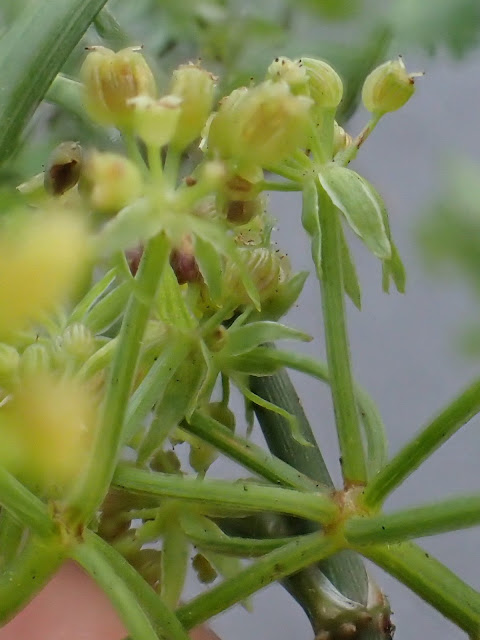1. Hedgerow Crane's-bill - Geranium pyrenaicum
Yesterday Tue 28 Sept, just when I think I am finishing finding new flowers, I park at Booths - busy because it is market day - and step of my car, almost onto Hedgerow Crane's-bill.
I shall write a little about this small Crane's-bill at Booths - then I shall add 3 "red" flowers from Giggleswick Station. I returned there on Sunday afternoon in the sun and brought my total of plants in flower there now (well on Sunday) to 44 - so had better show you some whilst they are still out.
 |
| It is in the flower-bed near those big pink flowers above beside the wall of Millennium Garden as you enter the car park from the north |
The basal leaves are very similar to Cut leaved Crane's-bill (see two days ago) and to Dove's-foot Crane's-bill and to (though I don't think I have seen it here) Small Flowered Crane's-bill)
However the hairs on the petioles (leaf stalks) are different. Cut leaved cranesbill has downward pointing hairs.
Hedgerow Crane's-bill has very short hairs (0.1mm) including glandular hairs and also some long ones 1.5 mm
#
 |
| We found some Geranium pyrenaicum Hedgerow Crane's-bill the previous day at Asenby and it had the same brown fungus disease. |
 |
| G pyrenaicum is supposed to have 10 anthers. (whereas the very similar G pusilum - Small flowered Crane'-bill has 10 filaments but only 5 of them have anthers. In this picture I think I can persuade myself that there are at least 6 anthers. ------------------------------------------------------ 2. Common Vetch - Vicia sativa In Giggleswick Car park on Sunday27 Sept I found Common Vetch. This is NOT common around here. Common Vetch usually has just one flower coming out at a time at a node, whereas the much more common and more purply Bush Vetch has several flowers at a time. In common Vetch the leaflets are narrow, but they are widest above the middle. The leaves have a big notch at the tip with quite a long green point coming out of it. |
3. Knapweed. Centaurea nigra.
Yes I could have entered this two month's earlier growing in verges and in old haymeadows. But there are still a few red (well purple) heads left.
I love the involucral bracts. (the brown scales round the flowrhead)
Here is the one from Giggleswick Station

Here are two from Horton (admittedly 7 miles from Settle) whihc I keyed out as Epilobium tetragonum.

Reflection on 30 September
(I reflected on 21 June, 3 months ago.. so it is time to reflectg again)
Lockdown Walks? -
Yesterday Craven went "orange" on the national map - with four times the number of people catching Covid as the natieonal average - as measured by new people tested positive each day -
Craven
117
cases per 100,000 people in the latest week 21 Sep-27 Sep. The average area in England had 28.
67
cases in the latest week 21 Sep-27 Sep
+27
compared with the previous week
430
total cases to 30 Sep
It is heartening that there have been no more deaths (I think) in the first fortnight of September. I keep checking that 68 number every evening. The results don't show the last fortnight, or deaths in October which will come from the increase in cases.
At the moment Lancashire (and the border is only 6 miles away south) and West Yorkshire (twenty miles to the east) are under extra lock down conditions - though people are still allowed to travel -
A man buying chips at the Fish and Chip shop this evening, with his woolly hat almost down to his nose, and his mask from his neck up to over his nose said through his thick mask "It will be the whole country next week."
It so sad for so many people who have relatives locked up in Old Peoples Homes and the relatives cannot visit them. Especially if the people have dementia or are the very end of their lives.
--------------
I am involved with the National Organisation Green Christian. Its members generally are wanting their churches to be greener, and to do more to look after the environment.
It is amazing the number of Green Services and Youtube videos now available. And their quality is improving. I /We can't watch all of them now - At the moment I think their rate of appearance is exponential . and they are getting better as people get ideas from each other.
I would of course recommend the GC Online Festival 23-25 October. (Which I will miss if I am able to run the Postponed Grasses course at Juniper Hall, but can watch the festival afterwards.)
Just as the increase in Covid cases is going exponential as people meet in crowds in and out of pubs.
Just a Climate Change effects can be exponential - but we are too scared so ignore them
But just as effects to reduce climate change could be implemented if the government had the courage.
Two Days ago Boris said something to the effect that 26% of UK has land designated for Nature Conservation and that he will increase it to 30 percent by 2030.
That the government will increase the area is encouraging. But the current 26 percent includes national parks which includes my house, caravan parks and many other villages and buildings and at least semi-intensive farmland.
Only 10 percent is designated for nature conservation and half of that is "in unfavourable" condition
---------
From next week I am going to be involved in organising some British Lichen Society Zoom Chat Meetings so will have less time for flowers.
I have been recording for 82 days (there are 4 "gap days" to catch up on later in autumn/winter) and have covered 240 species.







































































